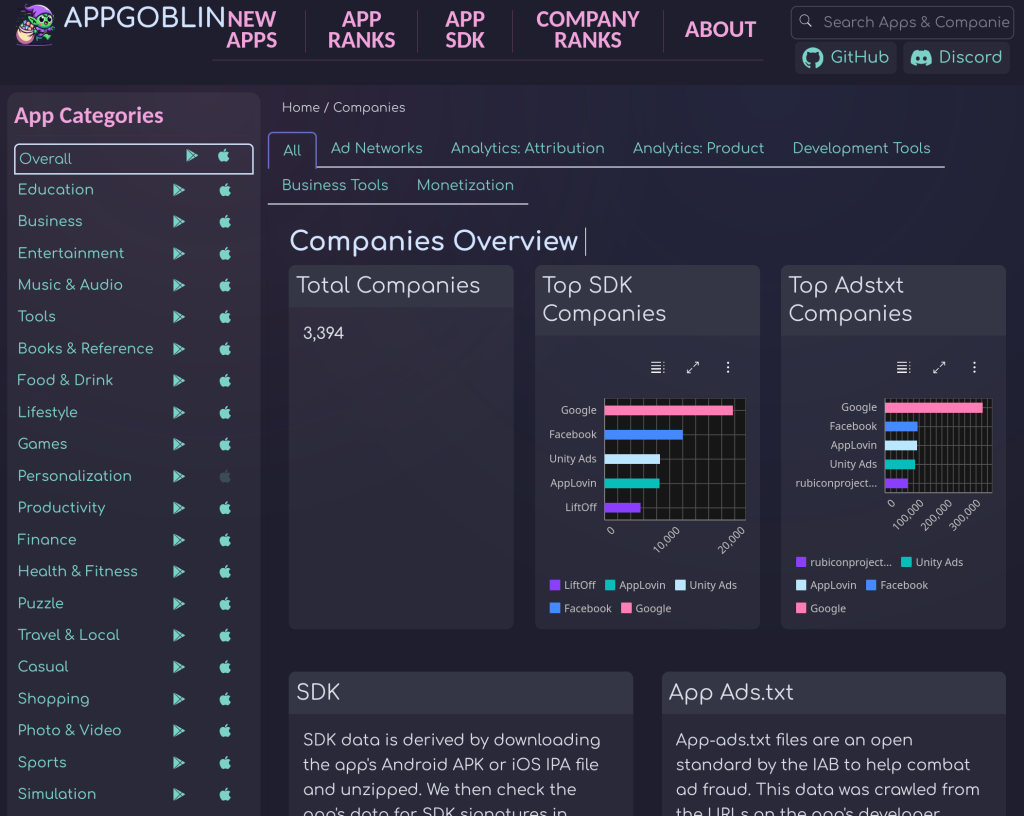
Theme & Svelte updates
First off, new theme courtesy of the upcoming v3 for skeleton.dev, a great UI library for Svelte. The new Skeleton v3 is pretty awesome and was quite easy to update along with moving from Svelte 4 to 5. Svelte 5 was a bit trickier with all the new runes, but overall it went pretty smoothly.
New Feature: Company Types
I’ve now added a combination of company types and categories such that you can look for detailed information
Types of Mobile App Service Companies:
- Ad Networks: My friend asked me “what is an ad network”, the answer is basically anything. I’ve held off breaking apart some of the more obvious subcategories like mediation platforms, offerwalls etc because at the end of the day, they are all ad networks in one way or another. I would like to get into a bit more detail breaking them apart, but likely will need to plan ahead more.
- Ad Attribution (MMPs): These are analytical companies that offer attribution as their core service. These are easy to distinguish from other analytic companies which often at best can only import data from the MMPs.
- Product Analytics: These are the top product analytic companies for iOS and Android.
- Development Tools: These ‘companies’ are a bit different because they include open source tool libraries and software. I’ve had a bit of trouble here conceptually since some big ad networks like Facebook and Google, also maintain some very core open source software that mobile developers use without any connection to the ad networks. Some examples of this are low level Swift libraries like FBLPromises.framework which I believe ultimately would be traced back to Google’s opens source Promises. Ultimately, this is something I do want to track, but I want to be careful not to conflate those open source libraries with the parent ad company. Another complicated, but perhaps more clear example would be the Unity3d vs Unity Ads. Unity is used to build games, and Unity Ads is a checkbox that installs Unity Ads plugins. This makes tagging various parts of SDKs a bit tricky. And again, many games that use Unity do not use Unity Ads.
- Business Tools: A catch all for business services for mobile app companies. The list here is short for now but contains a wide variety of companies such as RevenueCat which helps mobile developers manage their IAP and Subscriptions and Salesforce the largest CRM which has a surprisingly small share of the mobile app market, so perhaps I’ll need to look for more signs of their SDKs.
- Monetization: Shoot, this one is a loose end. Currently only two companies here and I can’t quite bring myself to move them to Ad Networks or to move some of the Ad Networks to monetization. I think the ultimate answer here is to say they are Ad Networks… but I really want to find a good way to compare Monetization platforms. I’ll let this one marinate a bit.
New Feature: Company Categories
Now THIS is my favorite. By combining the above Company Types, we can get detailed info on which companies have the biggest footprints in each mobile ecosystem. Here are just some examples:
- Biggest News Ad Networks: Woah, Amazon Ads is #3! I would have never guessed. It looks like Amazon Ads has lots of bigger Android apps using them like FlipBoard and DailyHunt.
- Most used Attribution for eCommerce: Branch continues to rise, now to #2 while surprisingly Adjust has fallen quite far.
- Top Simulation Game Ad Networks: OK, Google & FB of course. But I’m surprised how neck and neck AppLovin and Unity are given AppLovin’s recent skyhigh stock valuations. I’ll need to look into this more, so perhaps the next blog. Mostly I’ll need to make sure I’m not over counting any Unity SDKs which are not actually for ads. Of course, this also could be that games that use Unity Ads SDK still end up with AppLovin at the top of the waterfall / bid stack.
New Feature: SDKs & SDK parts
These are all the iOS and Android SDKs parts I’ve found in AndroidManifest’s iOS info.plist and directories, for all apps and companies. Many of these are untagged OS services (eg android.intent.action.MAIN, which nearly, but not every?, Android app uses). At some point, related to the above discussion of Development Tools, I’ll tag these as OS services used by Android / iOS so they can be filtered out.
Next up?
I don’t know! If you have ideas please reach out on Discord or LinkedIn. No matter what though, I’m happy with where AppGoblin has gotten to and looking forward to see where it goes next.